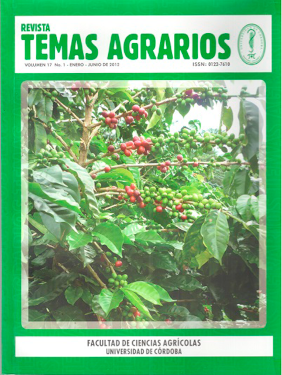Bioecology corn stem weevil Linogeraeus capillatus (LeConte) (Coleoptera: Curculionidae) in the department of Cordoba-Colombia
Bioecología del picudo del tallo del maíz Linogeraeus capillatus (LeConte) (Coleoptera: Curculionidae) en el departamento de Córdoba-Colombia

This work is licensed under a Creative Commons Attribution-NonCommercial 4.0 International License.
Show authors biography
In the Colombian Caribbean has emerged Linogeraeus capillatus becoming important in the corn agroecosystem reported in the municipalities of Codazzi-Cesar in 1975, in San Onofre-Sucre and in the municipalities of Montería, Cereté, Ciénaga of Oro, San Carlos, San Pelayo, Cotorra, Lorica, Chimá in the department of Córdoba. The objective of this research was meeting its aspects bioecological covering the life cycle and morphological characterization of the instars, for this is counted 350 larvae discriminated in different instars. Newly emerged pairs were confined in entomological cages 50x50 cm completely healthy corn plants and confirmed by destructive sampling density of larvae present. Under laboratory conditions at a temperature of 29,23°C, the egg had a life period of 5,3 days, the larvae 158,2 days and the pupa 34,44 days. The number of eggs by oviposition ranges 22 to 24 eggs (4,4 to 4,8 eggs / plant), with average length of 1 mm. The larvae have five instars, which develop within the plant. Sorghum halepense weeds and Dichanthium aristatum were the main host plants for adult L. capillatus. As natural enemies of adult of L. capillatus predators were recorded in the order Araneae families represented by Dipluridae and Lycosidae, while the depredations of the larval stages the ants of the genus Solenopsis exercised.
Article visits 1766 | PDF visits
Downloads
- Centro Agronómico Tropical de Investigación y Enseñanzas. Catie. 1990. Guía para el manejo integrado de plagas de maíz. Costa Rica. 88p (serie técnica, informe técnico/CATIE; N° 152).
- Centro Internacional de Mejoramiento de Maíz y Trigo. Cimmyt. 2000. México-Veracruz. URL:http://maizedoctor.cimmyt.org/es/ plagas-y-enfermedades/325?task=view. [Fecha de consulta: 12/4/2011].
- Heinrichs, E.A., Marlin, E. R., Foster, J.E. y Ochoa, J. M. 2000. Insectos plaga del maíz en Norteamérica. En: E. B. Radcliffe y W. D. Hutchison [eds.], Radcliffe: Texto Mundial de MIP, URL: http://ipmworld.umn.edu, Universidad de Minnesota, St. Paul, MN.[Fecha de consulta: 22/3/2011].
- Instituto Colombiano Agropecuario. ICA. 2006. El picudo del maíz Centrinaspis sp. (Coleoptera: Curculionidae) en el departamento de Córdoba. Boletín de sanidad vegetal N° 46. Pág. 17.
- Metcalf, C.L; Flint, W. P. 1984. Insectos destructivos y útiles sus costumbres y su control. México, Editorial Continental S.A, 1208 p.
- Stehr, W. F. 1991. Immature Insects. Departamant of Entomology
- Michigan State University. Systematic Entomology Laboratory, USDA. Vol. 2. 594-607 p.
- Thompson, R. T. 1992. Observations on the morphology and classification of weevils (Coleoptera: Curculionoidea) with a key to major groups. J. Nat. Hist. 26: 835- 891.
- Villarreal, N. 2006. EL picudo del maíz Centrinaspis sp. (Coleoptera: Curculionidae) en el departamento de Córdoba. Instituto Colombiano Agropecuario ICA. Boletín de Sanidad Vegetal 46. Produmedios. Bogotá. 18 p.
- Villarreal, N. 2003. Principales problemas sanitarios afectan la producción de maíz y sorgo en córdoba y una propuesta de manejo. en: memorias del seminario de actualización del cultivo de maíz. Federación nacional de cultivadores de cereales y luguminosas. FENALCE. Cereté. 60 p.




















